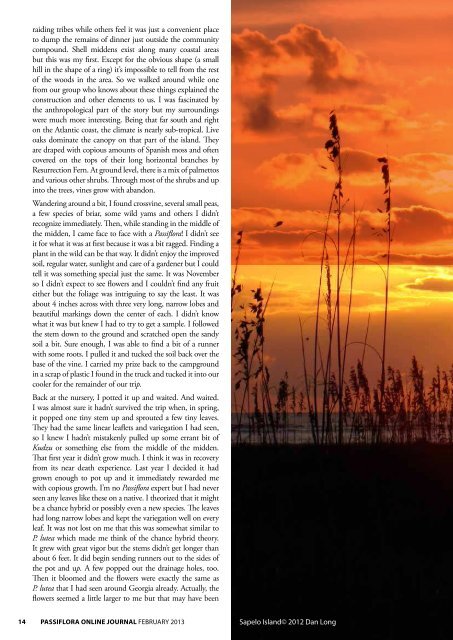Issue 3 2013 Lo-res PDF - Passion Flowers
Issue 3 2013 Lo-res PDF - Passion Flowers
Issue 3 2013 Lo-res PDF - Passion Flowers
You also want an ePaper? Increase the reach of your titles
YUMPU automatically turns print PDFs into web optimized ePapers that Google loves.
14<br />
raiding tribes while others feel it was just a convenient place<br />
to dump the remains of dinner just outside the community<br />
compound. Shell middens exist along many coastal areas<br />
but this was my first. Except for the obvious shape (a small<br />
hill in the shape of a ring) it’s impossible to tell from the <strong>res</strong>t<br />
of the woods in the area. So we walked around while one<br />
from our group who knows about these things explained the<br />
construction and other elements to us. I was fascinated by<br />
the anthropological part of the story but my surroundings<br />
were much more inte<strong>res</strong>ting. Being that far south and right<br />
on the Atlantic coast, the climate is nearly sub-tropical. Live<br />
oaks dominate the canopy on that part of the island. They<br />
are draped with copious amounts of Spanish moss and often<br />
covered on the tops of their long horizontal branches by<br />
Resurrection Fern. At ground level, there is a mix of palmettos<br />
and various other shrubs. Through most of the shrubs and up<br />
into the trees, vines grow with abandon.<br />
Wandering around a bit, I found crossvine, several small peas,<br />
a few species of briar, some wild yams and others I didn’t<br />
recognize immediately. Then, while standing in the middle of<br />
the midden, I came face to face with a Passiflora! I didn’t see<br />
it for what it was at first because it was a bit ragged. Finding a<br />
plant in the wild can be that way. It didn’t enjoy the improved<br />
soil, regular water, sunlight and care of a gardener but I could<br />
tell it was something special just the same. It was November<br />
so I didn’t expect to see flowers and I couldn’t find any fruit<br />
either but the foliage was intriguing to say the least. It was<br />
about 4 inches across with three very long, narrow lobes and<br />
beautiful markings down the center of each. I didn’t know<br />
what it was but knew I had to try to get a sample. I followed<br />
the stem down to the ground and scratched open the sandy<br />
soil a bit. Sure enough, I was able to find a bit of a runner<br />
with some roots. I pulled it and tucked the soil back over the<br />
base of the vine. I carried my prize back to the campground<br />
in a scrap of plastic I found in the truck and tucked it into our<br />
cooler for the remainder of our trip.<br />
Back at the nursery, I potted it up and waited. And waited.<br />
I was almost sure it hadn’t survived the trip when, in spring,<br />
it popped one tiny stem up and sprouted a few tiny leaves.<br />
They had the same linear leaflets and variegation I had seen,<br />
so I knew I hadn’t mistakenly pulled up some errant bit of<br />
Kudzu or something else from the middle of the midden.<br />
That first year it didn’t grow much. I think it was in recovery<br />
from its near death experience. Last year I decided it had<br />
grown enough to pot up and it immediately rewarded me<br />
with copious growth. I’m no Passiflora expert but I had never<br />
seen any leaves like these on a native. I theorized that it might<br />
be a chance hybrid or possibly even a new species. The leaves<br />
had long narrow lobes and kept the variegation well on every<br />
leaf. It was not lost on me that this was somewhat similar to<br />
P. lutea which made me think of the chance hybrid theory.<br />
It grew with great vigor but the stems didn’t get longer than<br />
about 6 feet. It did begin sending runners out to the sides of<br />
the pot and up. A few popped out the drainage holes, too.<br />
Then it bloomed and the flowers were exactly the same as<br />
P. lutea that I had seen around Georgia already. Actually, the<br />
flowers seemed a little larger to me but that may have been<br />
Passiflora Online Journal February <strong>2013</strong><br />
exploring<br />
I’m always<br />
for plants.<br />
Passiflora lutea<br />
Sapelo Island© 2012 Dan <strong>Lo</strong>ng<br />
‘Sapelo’ buds © 2012<br />
Dan <strong>Lo</strong>ng<br />
Passiflora Online Journal February <strong>2013</strong> 15
















